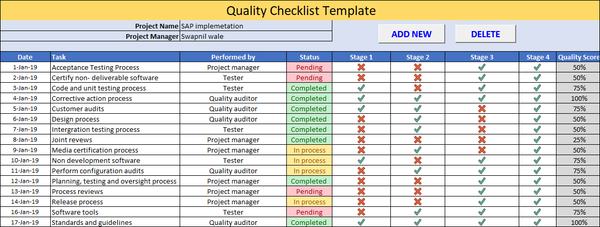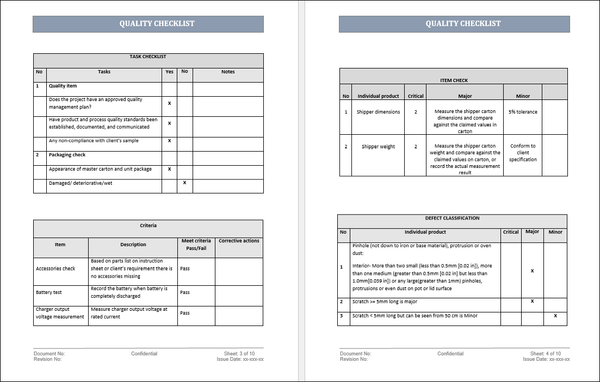Quality Checklist
The quality checklist template is a document that can help you keep track of what needs to be done when working on a project. This will help you to ensure that everything has been completed and nothing has been forgotten. You can use a quality checklist to ensure that you are capturing all the necessary information. This is especially important for making sure you have documented your findings and completed the work order according to your company's procedures. Quality checklists are used to ensure that the policies of activity have been followed. They allow for continuous improvement and promote best practices.

Elements of a Quality Checklist
Gather Requirements
A vast portion of inspections fail because the product fails to meet the stakeholder requirements. Please discuss with the stakeholders or suppliers and describe their needs in detail. For example, If you are a construction firm, discuss your requirements with the supplier regarding the quality and quantity of raw material required. This will protect your capital in the long run.
Product Testing
gather resources and list them, including the procedures you undergo to test the product quality. It is essential to clearly state the equipment required for testing and who will provide them. If you are importing it from a third-party source, make sure you follow up to get it on time.
Classification
Apart from specifying what problems to report, quality auditors should classify what category the issue comes under. It can be classified under three categories:
1.Minor: defects that are not noticeable or won't have a negative impact on the user. These defects won't affect the performance of the product and customer is less likely to return them.
2.Major: these defects are noticeable but won't cause a safety threat to the customer or environment. This can cause the customer to return the product and request a refund.
3.Critical: defects may cause damage to the user or environment. This can put the business at risk of liability or lawsuit issues. It can also harm the company's goodwill.
Quality Planning
Quality planning is a process that ensures the quality of products or services in all stages of production. It is also a way to mitigate risks and ensure customer satisfaction. The goal for quality planners is to create an effective system with procedures documented and communicated effectively throughout the company's structure. If your company lacks quality, you'll never get ahead or maintain a competitive edge over others in the industry.
Importance of Quality Planning In Project Management
1. Stakeholder confidence- Regular quality tests/reviews mentioned in the plan will win the trust of stakeholders that the product will be delivered as per their requirements. They will be notified regarding any tests, problems, and corrective actions taken.
2. Consistent improvement- A Quality plan will ensure efficiency and effectiveness where lessons learned from past projects will be documented and carried on to future projects. This will reduce costs and time in the long run leading to customer satisfaction and enhanced employees' productivity.
3. Delegates Accountability- A quality assurance plan will assign responsibilities to the right people who have the skills and expertise to perform their tasks. The manager will then confirm the schedule in interaction with the stakeholder. This will help reduce the risks involved regarding budget, allocation of resources, and completing the projects on time.
Quality Planning Concepts and Terminology
We will explore some of these concepts:
•Regulate what attributes of a final product are essential from a quality and customer point of view.
•Ensure excellence in these attributes from the beginning to the end of the project
•Design and implement a surveillance program to ensure quality at each stage. Ensure proper testing is done at each cycle to prevent drastic errors at the final stage of the project.
•Develop frameworks to observe and avoid any loopholes in quality.

Quality Can Never Be Predicted.
No matter how many times employees cross-check their work, there will always be room for improvement. They may feel they have done their best, but they need someone more experienced and skilled to rectify their mistakes. This is where they need a quality assurance team. Their responsibility is to ensure quality standards are being met. Explain their roles to the employees, so they feel their abilities are not being suspected. Encourage individuals who report potential problems that might be ignored in the later stage.
Quality Control Measurements
Quality control measurements are necessary for an organisation to maintain the quality of its products. Several metrics can measure quality control, which may vary depending on the type of product or service being provided. These measurements can be used for many different purposes, including project management tasks like estimating time frames or identifying high-risk areas where bugs may occur in future programs.
Control Quality
Control quality ensures the product or services meet the quality standards and procedures. It is a process of inspecting the quality standards of the raw materials sold by the seller. It also monitors and documents the steps involved in conducting quality assurance to make changes in the future if necessary.
The following are the benefits of control quality:
1.It meets the quality standards set by my stakeholders and business leaders.
2.Documents the cause of poor quality and prevents such issues
3.Recommends solutions to eliminate inferior product or service quality
4.Prevention of loss- The cost incurred in preventive measures is less than the repairing cost or cost incurred to recover the losses due to failure. The preventive price can be related to training, documenting the changes and processes, upgrading any equipment if required.
5.Customer satisfaction- There cannot be quality when the customer is not happy using your product. Even if the product has cleared all the quality parameters set by the company it is essential to take feedback from the customer as they are the ones you are building your product for. The main objective of implementing quality control is to manage both customers and stakeholders. Maintain transparency and share updates with your customer regarding any modifications or changes in the product.




